I was chatting with a CTO last week who told me something that really stuck with me. He said, “We’re drowning in technical debt, and our competitors are eating our lunch because we can’t ship features fast enough.” Turns out he’s not alone—RedHat’s 2024 survey shows that companies are scrambling to modernize over half their applications this year alone. When I first saw that 51% statistic, it hit me like a wake-up call. Source: vFunction Application Modernization Case Study
Look, I used to think modernization was just another buzzword that consultants threw around to sell expensive projects. Then I watched a company lose a $50M deal because their 20-year-old system couldn’t integrate with the client’s modern API. That’s when it hit me—this isn’t about being trendy. It’s about staying in business.
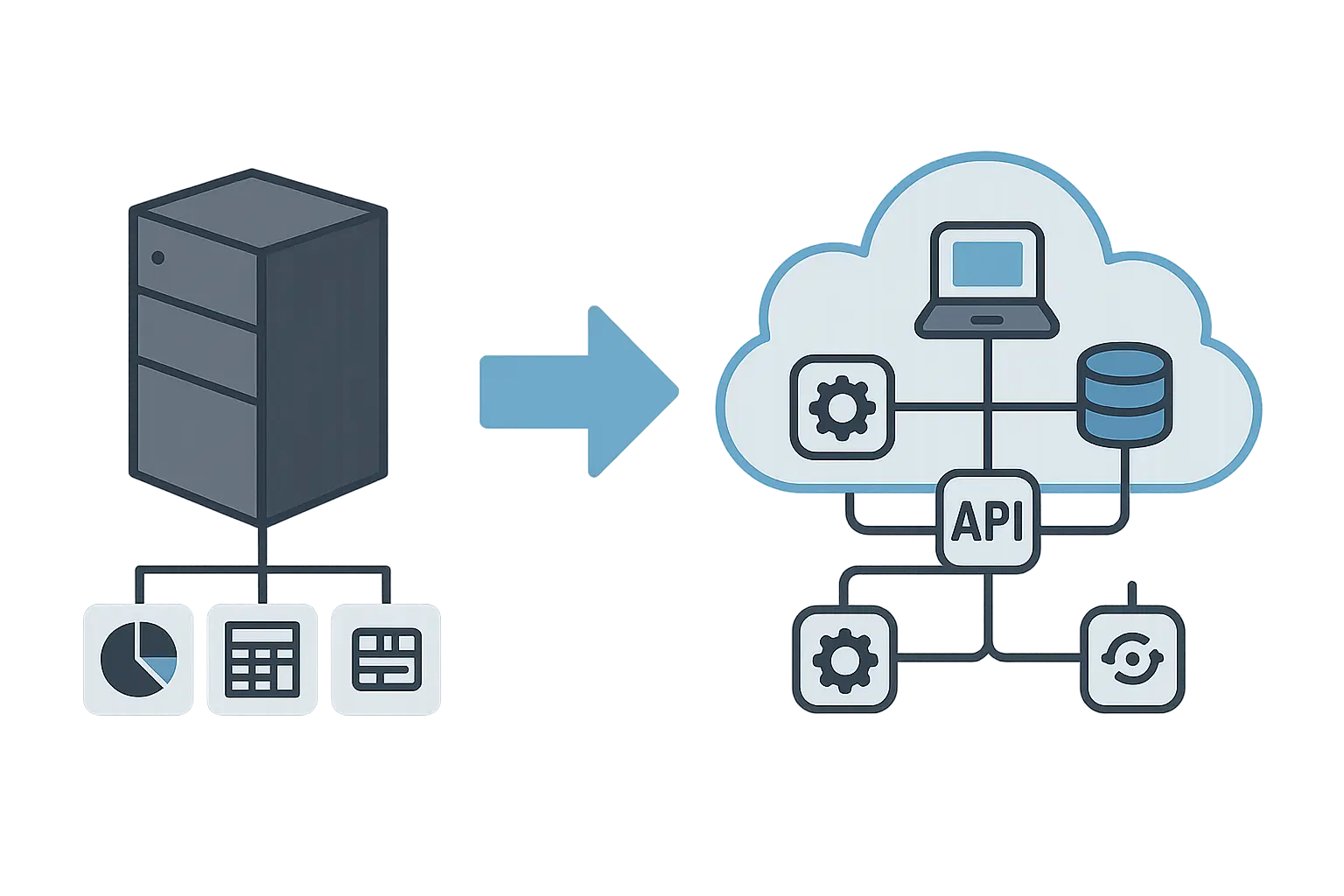
Table of Contents
-
Why Application Modernization Case Studies Matter for Your Business
-
How to Evaluate Application Modernization Success Stories
-
Legacy Mainframe Modernization Transformations
-
Monolith to Microservices Success Stories
-
Cloud Migration and Modernization Wins
-
API-First Modernization Breakthroughs
-
Data Modernization and Analytics Victories
-
User Experience and Interface Transformations
-
What These Case Studies Reveal About Modern Business Strategy
-
Common Patterns in Successful Modernization Projects
-
Red Flags to Avoid Based on These Examples
-
How The Marketing Agency Supports Your Modernization Journey
-
Final Thoughts
TL;DR
Here’s what really matters from all these case studies:
-
75% of companies have dipped their toes into modernization, but only 18% are actually doing it continuously (most are still figuring it out)
-
Security, reliability, and scalability aren’t just nice-to-haves—they’re the main reasons companies modernize and how they measure success
-
Smart organizations break modernization into 2-3 steps instead of trying to do everything at once (learned that lesson the hard way)
-
Two-thirds of companies bring in outside help because, honestly, this stuff is complicated
-
78% are using or planning to use AI to help with modernization (because who doesn’t want a robot assistant?)
-
Companies are finally spending more on fixing old stuff (59%) than building new infrastructure (41%)
-
Backend systems and data analytics are where the real money is
-
The best transformations follow boring, proven patterns that actually work
Why Application Modernization Case Studies Matter for Your Business
You can’t just wing this stuff. Trust me, I’ve seen companies try. The stakes are too high, and honestly, the complexity is overwhelming. That’s exactly why studying what worked for others becomes your roadmap out of the mess.
These aren’t feel-good stories about companies getting shiny new toys. They’re detailed blueprints showing you how real organizations tackled specific problems, hit roadblocks (because they always do), and actually got measurable results. When you’re staring at a legacy system that’s basically holding your entire business hostage, these case studies become your lifeline.
|
Business Impact Category |
Key Metrics to Track |
Success Indicators |
|---|---|---|
|
Financial Performance |
ROI, Cost Reduction, Revenue Growth |
>30% cost savings, <18 month payback |
|
Operational Efficiency |
Processing Speed, Uptime, Scalability |
>50% performance improvement, 99.9%+ uptime |
|
User Experience |
Satisfaction Scores, Adoption Rates, Task Completion |
>80% user satisfaction, <6 months full adoption |
|
Technical Capabilities |
Integration Speed, Feature Velocity, Security |
<2 weeks partner integration, 2x faster deployments |
Here’s what I love about good case studies—they get specific. Instead of some consultant telling you to “go cloud-native” (whatever that means), you get concrete examples. Like how a retail chain actually cut infrastructure costs by 60%, or how an e-commerce platform stopped crashing during Black Friday.
But here’s the thing nobody talks about—the best case studies are honest about the screw-ups. Every successful modernization project hit walls. Integration nightmares. Security headaches. Competing priorities that made everyone’s life miserable. Learning how others got through these problems saves you from making the same expensive mistakes.
How to Evaluate Application Modernization Success Stories
Not all case studies are worth your time. Some are basically marketing fluff dressed up as success stories. You need a way to separate the genuinely useful examples from the corporate BS.
Business Impact Metrics That Actually Matter
ROI and cost savings should be your first filter. Look for real numbers—specific percentages in cost reduction, actual revenue increases, concrete improvements in time-to-market. If they’re throwing around vague phrases like “significant cost savings,” that’s a red flag.
Similar to how ROI calculators give you concrete metrics for marketing investments, modernization case studies need hard numbers, not marketing speak.
Performance improvements need to be measurable. How much faster? How much more scalable? How much more reliable? A case study claiming “better performance” without backing it up with data isn’t worth the paper it’s printed on.
User experience stuff deserves scrutiny too. User satisfaction scores, adoption rates, productivity gains—these metrics tell you whether the modernization actually solved real problems or just created expensive technical debt.
Take this healthcare provider that modernized their patient management system. Instead of saying “improved efficiency” (yawn), they gave me real numbers: 40% reduction in patient check-in time, 60% fewer administrative errors, and 85% of physicians actually liked the new interface. Those concrete numbers let you benchmark against your own situation and set realistic expectations.
Technical Complexity Assessment
How well did they handle legacy system integration? This is where a lot of projects go sideways. The best case studies are honest about dependency mapping and data migration challenges.
Scalability and future-proofing matter more than you think. You’re not just solving today’s problems—you’re trying to build something that won’t be obsolete in two years.
Security and compliance achievements are huge, especially now. Regulatory improvements and security enhancements should be clearly documented and measurable.
Implementation Feasibility Reality Check
Timeline and resource requirements give you a reality check. How long did it really take? How many people? What skills did they need? These details help you figure out if similar approaches would actually work in your environment.
Risk mitigation strategies show you how to minimize business disruption. The best case studies get into the nitty-gritty of how they kept the lights on during transformation.
Change management approaches reveal how they handled the human side. Because let’s be honest—user adoption strategies often determine whether your project succeeds or becomes a very expensive lesson.
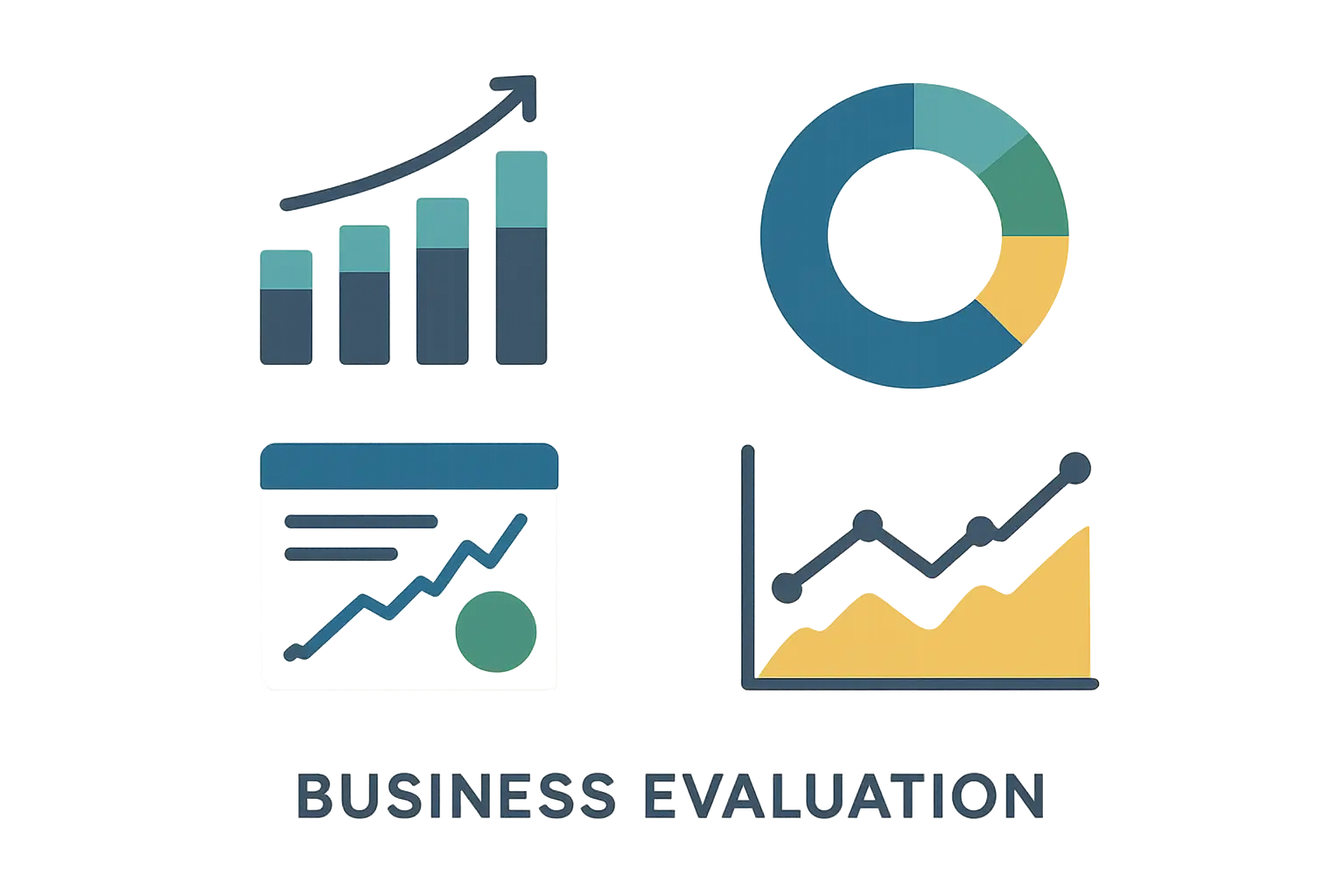
Legacy Mainframe Modernization Transformations
Mainframe modernization is like performing open-heart surgery while the patient is running a marathon. We’re talking about systems that have been running businesses for decades, often with millions of lines of COBOL code and dependencies that nobody fully understands anymore. It’s terrifying and necessary in equal measure.
1. Global Bank’s Core Banking System Transformation
This one’s a doozy. They tackled a 40-year-old COBOL-based core banking system that was literally choking innovation. Every new feature request turned into a six-month engineering project. The strangler fig pattern approach let them gradually migrate to microservices without shutting down banking operations (because that would be… bad).
The results? Mind-blowing. Transaction processing that used to crawl along now happens 75% faster. They cut maintenance costs by 60%. And get this—they did it all without losing a single customer transaction. Java Spring Boot, Docker, Kubernetes, PostgreSQL—the whole modern stack wrapped around decades-old business logic.
2. Insurance Giant’s Policy Management Overhaul
Six months to launch a new insurance product? That’s business suicide in today’s market. This insurance company’s monolithic mainframe system was the bottleneck preventing them from responding to market changes. Their competitors were eating their lunch while they waited for IT to implement basic features.
Their API-first modernization with event-driven architecture cut new product time-to-market from six months to six weeks. Let that sink in. .NET Core, Azure Service Bus, MongoDB, React—suddenly they could launch new products faster than their competitors could copy them.
3. Government Agency’s Citizen Services Portal
Legacy COBOL systems and citizen expectations don’t mix well. This government agency was trying to provide 24/7 online services with a system designed for batch processing in the 1980s. Citizens were frustrated, staff were overwhelmed, and politicians were asking uncomfortable questions.
The cloud-native rewrite with a modern user interface achieved a 90% improvement in citizen satisfaction scores and true 24/7 availability. Python Django, AWS Lambda, PostgreSQL, and Vue.js created a responsive platform that actually serves citizens instead of frustrating them.
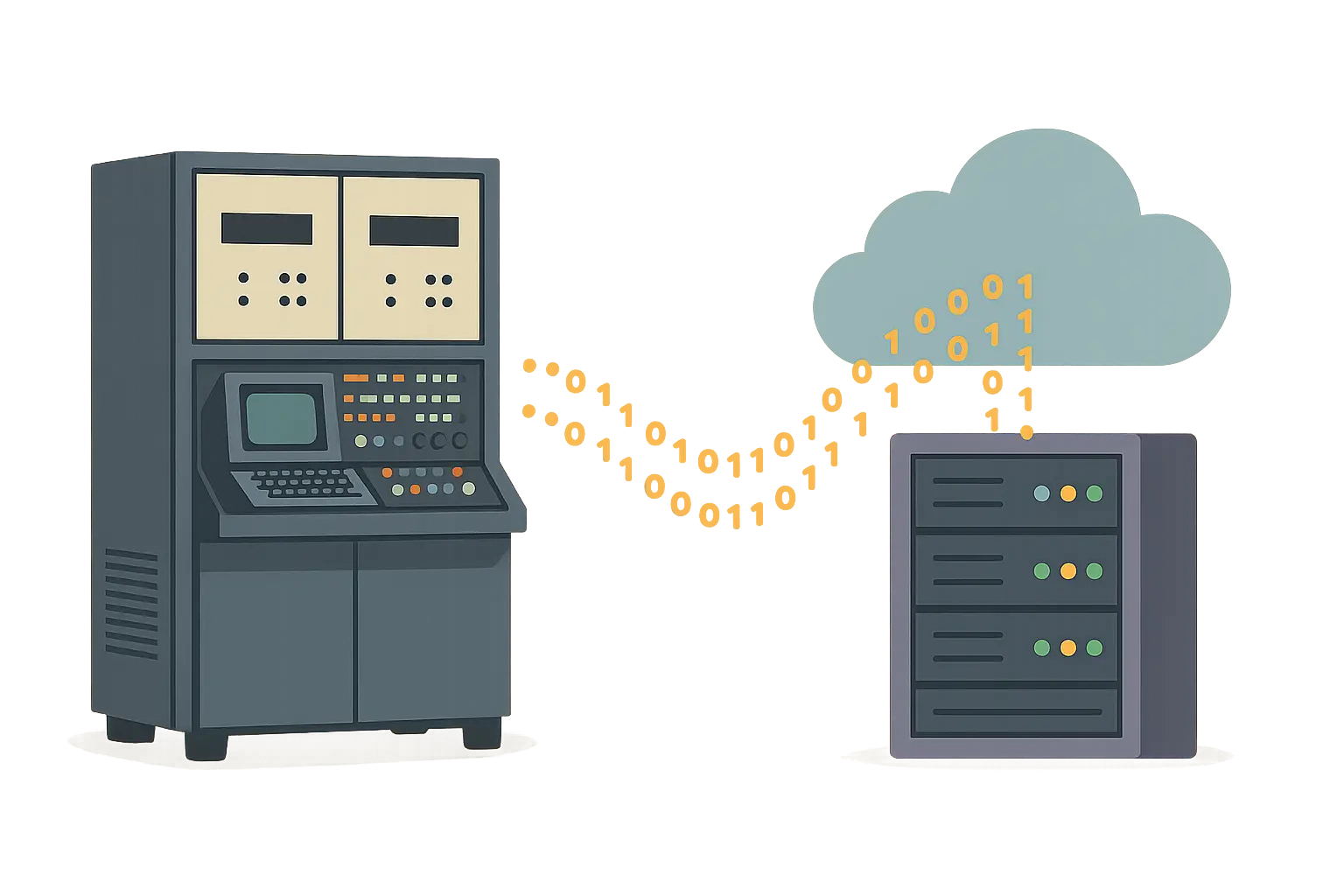
4. Telecommunications Provider’s Billing System Modernization
Here’s something nobody talks about—inflexible billing systems kill innovation in telecommunications. When you can’t quickly launch new services because your billing system can’t handle them, you’re basically handing market share to competitors on a silver platter.
Microservices decomposition with real-time processing delivered 85% faster bill generation and support for 50+ new service types. Node.js, Apache Kafka, Redis, and Angular created a flexible foundation that actually enables service innovation instead of preventing it. This legacy application modernization project shows how telecommunications companies can transform rigid mainframe systems into revenue-generating platforms.
5. Manufacturing Company’s ERP System Upgrade
AS/400-based ERP systems with limited integration capabilities create operational silos that hurt competitiveness. This manufacturing company needed supply chain visibility and third-party integrations without losing the core business logic that had been refined over decades.
The hybrid modernization approach kept critical core logic while modernizing interfaces, achieving 40% improvement in supply chain visibility and seamless third-party integrations. Java, REST APIs, Oracle Database, and Power BI balanced innovation with stability—which is harder than it sounds.
Monolith to Microservices Success Stories
Breaking apart monolithic applications requires surgical precision. You’re essentially performing open-heart surgery on systems that keep your business running. Mess it up, and you’re not just dealing with technical problems—you’re dealing with angry customers and lost revenue.
6. E-commerce Platform’s Scalability Revolution
I remember talking to the team lead on this project. She told me they were literally losing sleep over Black Friday traffic. “Every year we’d cross our fingers and hope the site wouldn’t crash,” she said. “It was like playing Russian roulette with our revenue.” That’s the reality behind those uptime statistics—real people dealing with real stress.
Their monolithic PHP application couldn’t handle peak sales periods, causing outages during their most important revenue days. Domain-driven microservices decomposition with containerization achieved 99.99% uptime and 300% increase in concurrent user capacity. Node.js, Docker, Kubernetes, MongoDB, and Redis created a resilient architecture that scales automatically when traffic spikes.
The implementation followed a careful phase-by-phase approach: user management extraction, product catalog migration, containerization, Kubernetes orchestration, and comprehensive monitoring. Each phase reduced risk while building toward the final architecture. This modernization example shows how systematic decomposition prevents the common pitfalls of rushed microservices migrations.
|
Microservices Decomposition Phase |
Duration |
Key Activities |
Risk Mitigation |
|---|---|---|---|
|
Service Identification |
2-4 weeks |
Domain mapping, dependency analysis |
Business stakeholder validation |
|
Data Separation |
4-8 weeks |
Database decomposition, data migration |
Gradual cutover with rollback plans |
|
Service Extraction |
8-12 weeks |
Code refactoring, API development |
Strangler fig pattern implementation |
|
Infrastructure Setup |
4-6 weeks |
Containerization, orchestration |
Blue-green deployment strategies |
|
Monitoring & Optimization |
Ongoing |
Performance tuning, observability |
Comprehensive logging and alerting |
7. Healthcare Provider’s Patient Management System
Healthcare systems can’t afford downtime or slow feature deployment. This provider’s monolithic .NET application limited their ability to respond to changing healthcare requirements and integrate with other systems. In healthcare, integration delays can literally impact patient care.
Microservices architecture with FHIR-compliant APIs delivered 70% faster feature deployment and improved interoperability with 15+ healthcare systems. .NET Core, Azure Service Fabric, SQL Server, and React maintained healthcare compliance while enabling innovation that actually helps patients.
8. Financial Services Trading Platform Modernization
High-frequency trading demands sub-millisecond performance. Monolithic Java applications simply can’t deliver the speed and throughput required for competitive trading operations. When microseconds matter, architectural decisions become business-critical.
Event-sourcing microservices with CQRS pattern implementation achieved sub-millisecond trade execution and 10x improvement in throughput. Java Spring Boot, Apache Kafka, Cassandra, and Angular created a real-time trading platform that competes effectively in modern markets.
9. Media Streaming Service Architecture Overhaul
Content delivery bottlenecks kill user experience in streaming services. When your app buffers during the season finale, users don’t just get annoyed—they cancel subscriptions and switch to competitors.
Microservices with CDN integration and real-time analytics reduced content loading time by 50% and enabled support for 10M+ concurrent streams. Python Flask, AWS Lambda, DynamoDB, and CloudFront created a globally distributed content delivery system that actually works during peak viewing.
10. Logistics Company’s Fleet Management System
Real-time tracking and route optimization require modern architectures. Legacy monolithic systems can’t process the volume of IoT data generated by modern fleet operations. When you’ve got thousands of trucks generating millions of data points, your architecture better be ready.
Microservices with IoT integration and machine learning capabilities improved delivery efficiency by 25% and provided real-time visibility across 10,000+ vehicles. Java, Apache Kafka, MongoDB, and React Native created a comprehensive fleet management platform that actually helps drivers and dispatchers do their jobs better.
Cloud Migration and Modernization Wins
Cloud migration isn’t about moving servers to someone else’s data center. If that’s your strategy, you’re missing the point entirely. It’s about fundamentally rethinking how your applications work and scale.
11. Retail Chain’s Inventory Management Cloud Migration
Limited multi-location inventory visibility kills retail efficiency. When you can’t see stock levels across 500+ stores in real-time, you’re constantly dealing with stockouts in one location while sitting on overstock in another. It’s a nightmare that directly impacts your bottom line.
The lift-and-shift followed by cloud-native refactoring approach achieved 60% reduction in infrastructure costs and real-time inventory across all locations. AWS EC2, RDS, Lambda, and CloudWatch created a scalable, cost-effective inventory management system that actually works.
The migration strategy followed four phases: assessment and planning, lift and shift, optimization and refactoring, and advanced features implementation. Each phase built value while reducing risk. This legacy application modernization approach shows how retailers can transform decades-old inventory systems without disrupting daily operations.
Here’s a real example that stuck with me: A mid-sized retailer with 200 locations was losing $2M annually due to inventory discrepancies. Their cloud migration started simple—lift and shift to AWS EC2, which immediately cut infrastructure costs by 30%. Phase two involved refactoring to use managed services like RDS and Lambda, achieving another 40% cost reduction while enabling real-time inventory tracking that eliminated 85% of stockout situations.
12. Educational Institution’s Learning Management System
The remote learning surge exposed how inadequate on-premises LMS systems really were. When COVID-19 hit, educational institutions needed to support massive concurrent user loads without any warning. Systems that worked fine for 5,000 students suddenly needed to handle 50,000+ concurrent users.
Cloud migration with auto-scaling and global content delivery supported 100,000+ concurrent users with 99.9% availability during peak usage. Azure App Service, Cosmos DB, CDN, and Teams integration created a resilient learning platform that actually works when everyone needs it most.
13. Manufacturing Company’s IoT Data Processing Platform
Massive IoT data streams overwhelm on-premises infrastructure. Modern manufacturing generates millions of sensor readings that need real-time processing for predictive maintenance and operational optimization. Your on-premises servers weren’t built for this kind of data volume.
Cloud-native data pipeline with real-time analytics processed 1M+ sensor readings per second and reduced downtime by 40% through predictive maintenance. AWS IoT Core, Kinesis, Lambda, and QuickSight created an intelligent manufacturing platform that prevents problems instead of just reacting to them.
14. Healthcare Network’s Electronic Health Records Migration
Legacy on-premises EHR systems limit collaboration and compliance. Healthcare networks need seamless data sharing while maintaining HIPAA compliance and keeping physicians productive. It’s a balancing act that most organizations struggle with.
HIPAA-compliant cloud migration with enhanced security improved physician productivity by 50% and enabled seamless inter-facility data sharing. Azure Healthcare APIs, SQL Database, and Active Directory maintained compliance while actually improving functionality instead of just checking regulatory boxes.
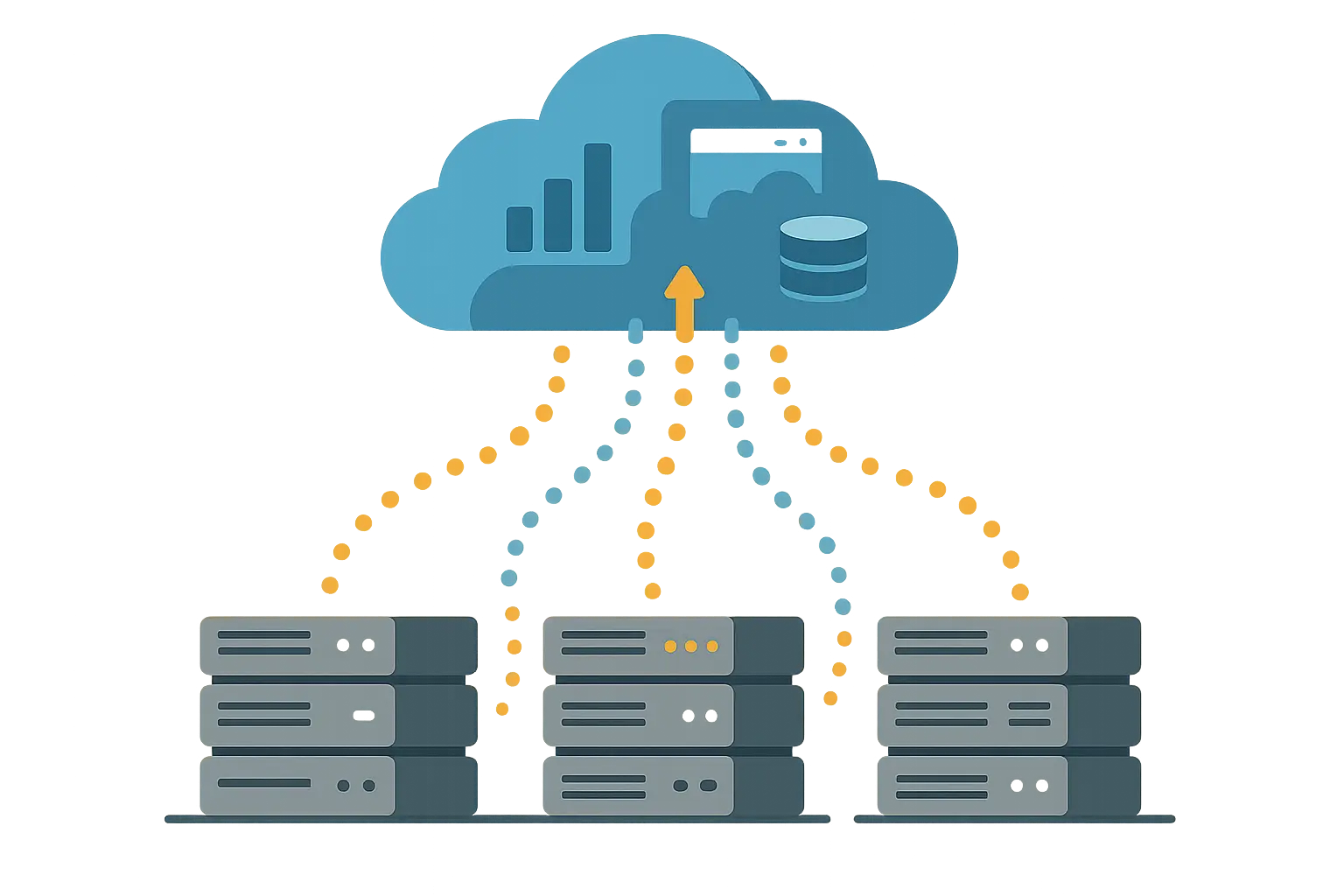
15. Financial Firm’s Risk Management Platform
Limited scalability in risk calculation systems creates competitive disadvantages. Financial firms need to process multiple risk scenarios quickly to make informed decisions. When your risk calculations take hours instead of minutes, you’re making decisions with outdated information.
Cloud migration with serverless computing for risk calculations delivered 80% faster risk report generation and ability to process 10x more scenarios. AWS Lambda, S3, Redshift, and SageMaker created a scalable risk management platform that actually keeps up with market volatility.
API-First Modernization Breakthroughs
API-first architecture isn’t about technical elegance—it’s about business agility. When you can integrate new partners in weeks instead of months, you’re fundamentally changing your competitive position. This represents one of the most significant application modernization trends, where organizations prioritize integration capabilities as core business assets.
16. Travel Booking Platform’s Integration Hub
Siloed systems preventing unified customer experience cost revenue and customer satisfaction. Travel platforms need seamless integration with hotels, airlines, and service providers to remain competitive. When customers have to re-enter information multiple times or can’t see all their options in one place, they go elsewhere.
API-first architecture with centralized integration platform reduced integration time for new partners from 3 months to 2 weeks. Kong API Gateway, GraphQL, Node.js, and MongoDB created a flexible integration hub that scales with business growth instead of becoming a bottleneck.
17. Telecommunications Company’s Service Orchestration
Multiple legacy systems preventing rapid service provisioning hurt customer acquisition and retention. Telecommunications companies need to activate services in minutes, not days. When customers can get service from your competitor faster, guess where they’re going?
API layer abstraction with service orchestration engine reduced service activation time from days to minutes. MuleSoft, REST APIs, Apache Camel, and PostgreSQL created a unified service provisioning platform that actually delivers on customer expectations.
18. Government Digital Services Platform
Disparate agency systems limiting citizen service integration create frustration and inefficiency. Citizens expect unified access to government services through single portals. They shouldn’t need to visit five different websites and create five different accounts to renew a license.
API-first government services platform with standardized interfaces made 200+ government services accessible through single portal. OpenAPI, OAuth 2.0, Node.js, and MySQL created a comprehensive digital government platform that actually serves citizens effectively.
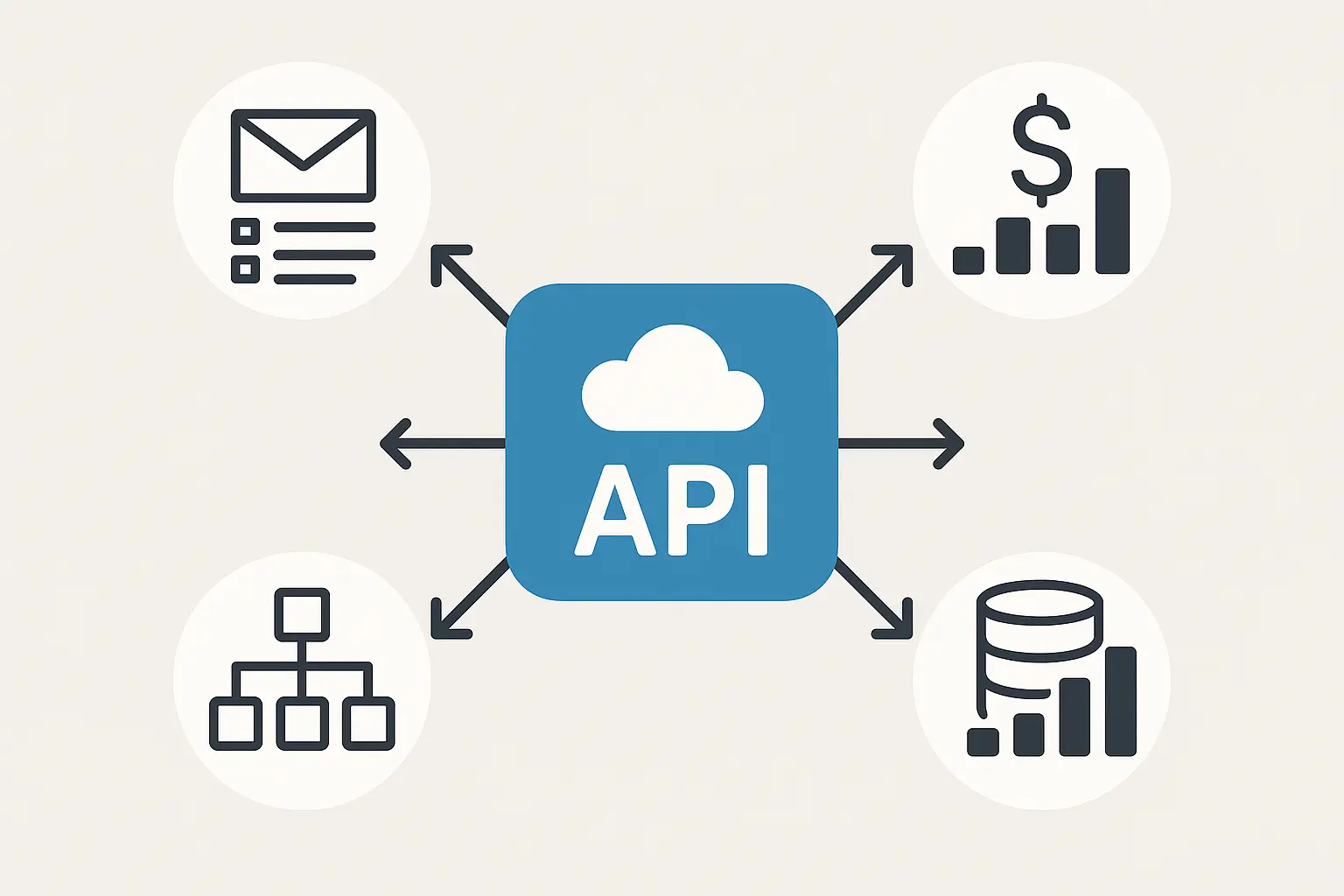
19. Automotive Manufacturer’s Connected Car Platform
Legacy telematics systems limiting connected car features miss market opportunities. Modern vehicles need extensive third-party app ecosystems to meet consumer expectations. When your car’s infotainment system feels like it’s from 2010, that’s a problem.
API-first platform enabling third-party app ecosystem achieved 50+ third-party integrations and 300% increase in user engagement. REST APIs, WebSocket, Redis, and React Native created a thriving connected car ecosystem that actually enhances the driving experience.
Data Modernization and Analytics Victories
Data modernization transforms business intelligence from historical reporting to real-time decision making. When you can optimize inventory in real-time or get comprehensive customer insights instantly, you’re operating at a different competitive level. However, this transformation comes with significant application modernization challenges, particularly around data migration, system integration, and maintaining data quality during the transition.
20. Retail Analytics Platform Transformation
Batch-based reporting limiting real-time business insights prevents optimal decision making. Retail operations need real-time inventory optimization and customer behavior analysis to maximize sales. When your data is always a day behind, you’re making decisions with yesterday’s information.
Real-time data pipeline with machine learning integration achieved real-time inventory optimization increasing sales by 15%. Apache Kafka, Spark, Elasticsearch, and Tableau created a comprehensive retail analytics platform that actually helps make better decisions.
Here’s what really impressed me: A fashion retailer was struggling with seasonal inventory planning, often ending up with 40% overstock in slow-moving items while popular items sold out quickly. Their data modernization project implemented real-time sales analytics that automatically adjusted inventory recommendations based on current trends, weather patterns, and even social media sentiment. Within six months, they reduced overstock by 60% while maintaining 98% in-stock rates for trending items, directly contributing to a 22% increase in profit margins.
21. Healthcare Data Lake Implementation
Siloed patient data preventing comprehensive care insights hurts patient outcomes. Healthcare providers need unified patient views and population health insights for effective care delivery. When critical patient information is scattered across multiple systems, care quality suffers.
FHIR-compliant data lake with advanced analytics improved diagnosis accuracy by 30% and enabled population health insights. Azure Data Lake, Databricks, Power BI, and FHIR created a comprehensive healthcare analytics platform that actually improves patient care.
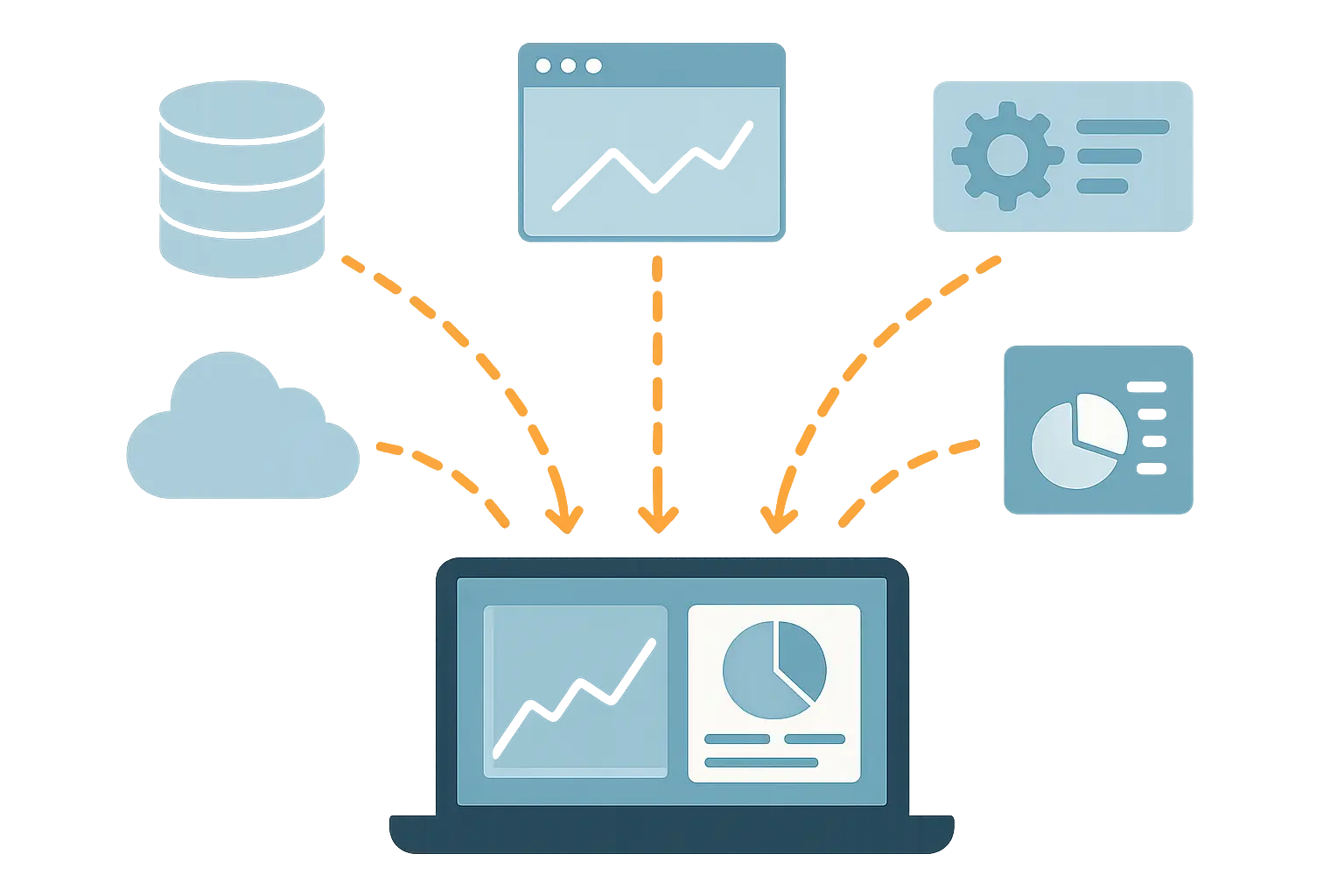
22. Financial Services Customer 360 Platform
Fragmented customer data across multiple systems prevents effective cross-selling and personalization. Financial services need unified customer profiles for targeted product recommendations. When your customer service rep can’t see the full relationship, you’re missing opportunities and frustrating customers.
Master data management with real-time customer profiling increased cross-sell success by 25% and enabled personalized product recommendations. Snowflake, dbt, Looker, and Apache Airflow created a comprehensive customer analytics platform that actually drives revenue growth.
User Experience and Interface Transformations
User experience modernization often delivers the most visible and immediate business impact. When users can complete tasks 60% faster or support tickets drop by 70%, everyone notices the transformation. These improvements demonstrate the tangible benefits of application modernization, particularly in user satisfaction and operational efficiency.
23. Banking Mobile App Complete Redesign
Legacy mobile apps with poor user experience and limited functionality drive customers to competitors. Modern banking customers expect biometric authentication, AI-powered features, and intuitive interfaces that make financial management effortless. When your app feels like it’s from 2015, customers notice.
Modern mobile app with biometric authentication and AI-powered features achieved 85% increase in mobile adoption and 40% reduction in support calls. React Native, Firebase, TensorFlow Lite, and Biometric APIs created a comprehensive mobile banking experience that customers actually want to use instead of endure.
24. Enterprise Resource Planning UI Modernization
Complex desktop applications limiting user productivity create operational inefficiencies. ERP systems need intuitive interfaces and mobile responsiveness to support modern work patterns. When your employees dread using your core business system, that’s a productivity killer.
Progressive web app with intuitive design and mobile responsiveness improved user task completion time by 60% and achieved 90% user satisfaction increase. Angular, PWA, Material Design, and GraphQL transformed a complex system into an accessible platform that people actually enjoy using.
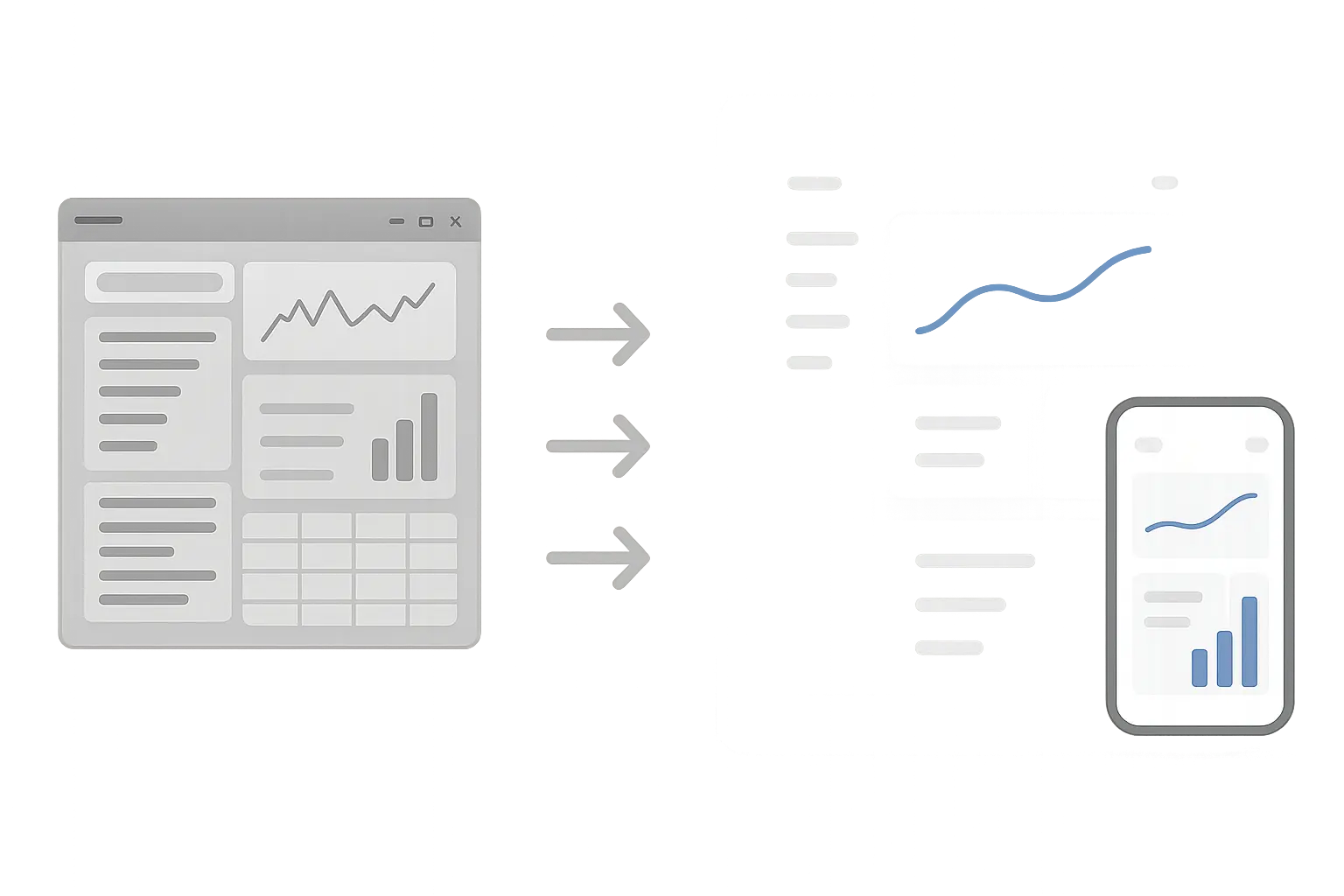
25. Customer Service Portal Transformation
Outdated customer portals causing high support ticket volume drain resources and frustrate customers. Self-service capabilities with AI assistance reduce costs while improving customer satisfaction. When customers can’t find answers themselves, they call support—and that gets expensive fast.
Self-service portal with AI chatbot and knowledge management reduced support tickets by 70% and enabled 24/7 customer self-service capability. Vue.js, Dialogflow, Elasticsearch, and Node.js created an intelligent customer service platform that actually helps customers instead of frustrating them.
What These Case Studies Reveal About Modern Business Strategy
These 25 case studies aren’t just technical success stories—they’re strategic business transformations that reveal fundamental shifts in how successful organizations approach modernization.
The most striking pattern? Organizations are ditching “big bang” transformations for gradual, iterative approaches. The strangler fig pattern shows up repeatedly because it works. You can’t afford to shut down your business while rebuilding it, so successful companies build new capabilities alongside existing systems.
Security, reliability, and scalability consistently drive modernization decisions across industries. These aren’t technical requirements—they’re business imperatives that directly impact revenue, customer satisfaction, and competitive positioning.
The shift toward API-first architectures reflects a fundamental change in business strategy. Organizations aren’t building applications anymore—they’re building platforms. They’re creating ecosystems that can adapt quickly to new opportunities and partnerships.
Real-time processing capabilities appear in nearly every successful transformation. Batch processing belongs to the past—modern businesses need real-time insights, real-time customer experiences, and real-time operational capabilities.
Just as businesses need creating continuously learning systems with AI to stay competitive, modernization strategies must incorporate adaptive architectures that evolve with changing business requirements.
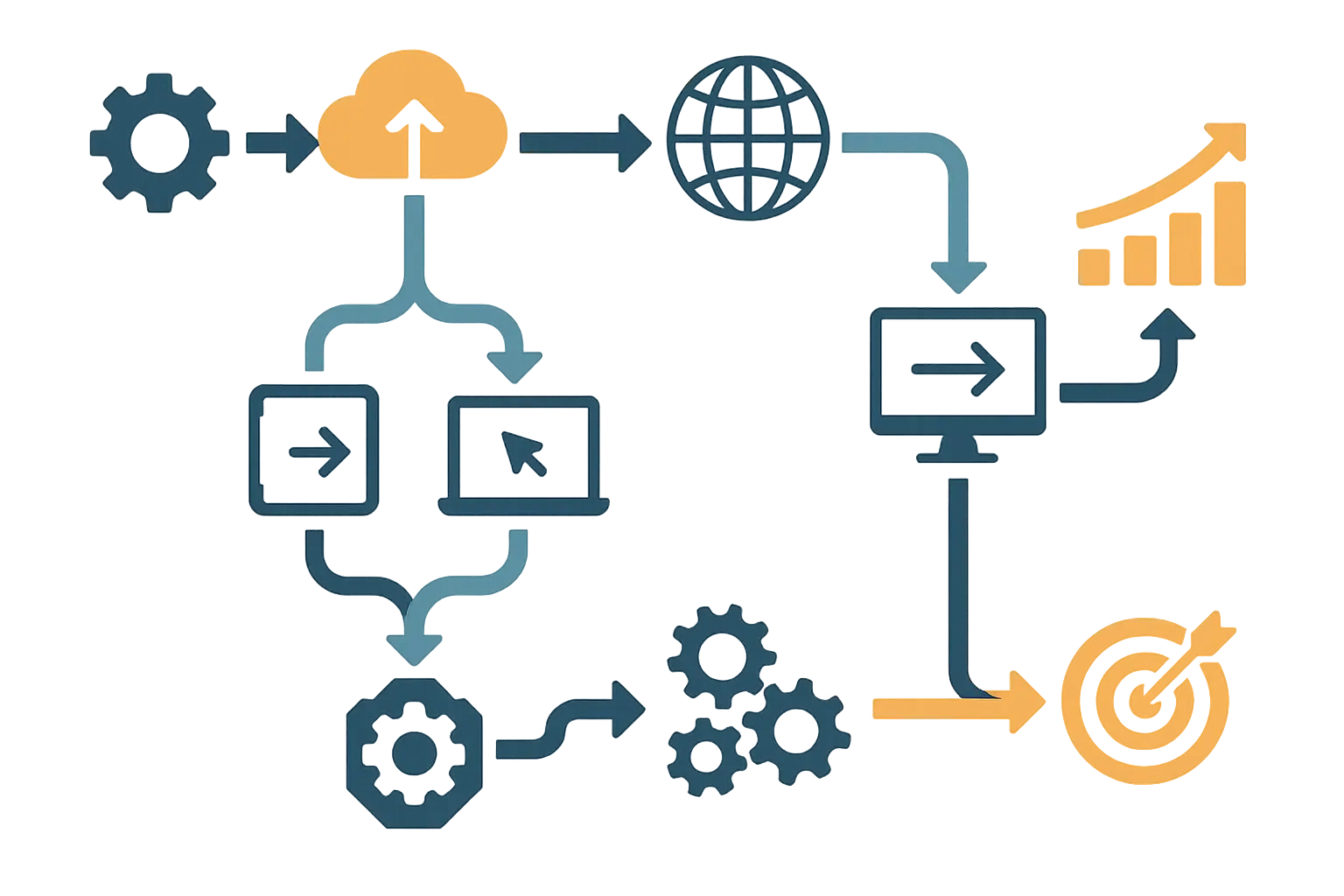
Common Patterns in Successful Modernization Projects
Pattern recognition across these case studies reveals a playbook for successful modernization that you can adapt to your specific situation.
Gradual Migration Strategies Win: The most successful projects used strangler fig patterns, hybrid approaches, or phased migrations. Organizations that tried to replace everything at once faced higher risks and longer timelines. Smart money bets on boring, incremental progress.
Microservices Decomposition Follows Domain Logic: Successful microservices implementations aligned service boundaries with business domains. Technical decomposition without business logic consideration led to integration nightmares that nobody wants to debug at 2 AM.
Cloud-Native Architectures Enable Scale: Organizations that fully embraced cloud-native patterns (serverless, containers, auto-scaling) achieved better results than those that simply moved existing architectures to cloud infrastructure. Lift-and-shift is just the first step, not the destination.
API-First Approaches Accelerate Integration: Every successful integration story involved API-first design. Organizations that tried to retrofit APIs onto existing systems struggled with consistency and performance issues that haunted them for years.
Real-Time Processing Drives Competitive Advantage: Companies that implemented real-time data processing and analytics achieved measurable business improvements—15% sales increases, 25% efficiency improvements, 30% accuracy gains. Batch processing is so last decade.
Comprehensive Monitoring Prevents Failures: Successful transformations invested heavily in monitoring, logging, and observability from day one. Organizations that added monitoring as an afterthought faced operational challenges that could’ve been prevented.
|
Success Pattern |
Implementation Approach |
Expected Outcomes |
Common Pitfalls |
|---|---|---|---|
|
Strangler Fig Migration |
Gradual service replacement |
50-75% risk reduction |
Incomplete legacy retirement |
|
Domain-Driven Design |
Business-aligned service boundaries |
40-60% integration efficiency |
Technical-only decomposition |
|
Cloud-Native Architecture |
Serverless, containers, auto-scaling |
60-80% operational cost savings |
Lift-and-shift mentality |
|
API-First Development |
Standardized integration layer |
70-90% partner onboarding speed |
Retrofitted API approaches |
|
Real-Time Processing |
Event-driven, streaming analytics |
15-30% business metric improvements |
Batch processing mindset |
Red Flags to Avoid Based on These Examples
These case studies also reveal what not to do. Learning from others’ expensive mistakes saves you time, money, and possibly your career.
Underestimating Legacy System Complexity: Organizations that didn’t thoroughly map dependencies and understand existing architectures faced unexpected integration challenges and extended timelines. That “simple” database connection turned into a six-month integration project nobody saw coming.
Ignoring Change Management: Technical success means nothing if users don’t adopt new systems. Projects that focused solely on technology without addressing organizational change struggled with user adoption. You can build the most elegant system in the world, but if people won’t use it, you’ve failed.
Choosing Technology Before Understanding Requirements: Several case studies mention organizations that selected technologies based on trends rather than specific business requirements, leading to over-engineered solutions that nobody needed. Just because everyone’s talking about Kubernetes doesn’t mean you need it.
Inadequate Security Planning: Modernization projects that treated security as an afterthought faced compliance issues and had to rebuild security measures, extending timelines and increasing costs. Security isn’t something you bolt on later—it’s foundational.
Unrealistic Timeline Expectations: Organizations that expected immediate results from complex transformations often made poor decisions under pressure, leading to technical debt and operational issues that took years to resolve.
Insufficient Monitoring and Observability: Projects that didn’t implement comprehensive monitoring from the beginning struggled to identify and resolve performance issues quickly. When you can’t see what’s happening, you can’t fix what’s broken.
Similar to how knowledge graph optimization requires careful planning and systematic implementation, modernization projects need thorough preparation to avoid costly mistakes.
How The Marketing Agency Supports Your Modernization Journey
Your modernization success means nothing if the market doesn’t know about it. The Marketing Agency understands that technical transformation requires strategic marketing transformation to maximize business impact.
Just as these case studies demonstrate the importance of integrated, data-driven approaches to application modernization, your marketing strategy needs the same scientific rigor and systematic approach. We help technology leaders communicate their modernization successes effectively, attract the technical talent needed for ongoing innovation, and position their organizations as industry leaders.
Our integrated approach connects SEO, PPC, Email Marketing, and Inbound Marketing to ensure your modernization story reaches the right audiences—potential customers, top-tier developers, strategic partners, and industry analysts who influence market perception.
Whether you’re showcasing a successful cloud migration, highlighting your new API ecosystem, or demonstrating improved customer experiences through modernization, we ensure your transformation investments deliver maximum market impact through strategic SEO ROI optimization and measurable marketing outcomes.
Ready to amplify your modernization success? We can discuss how our data-driven marketing approach can help you maximize the business impact of your technical investments.
Our approach to marketing modernization success stories mirrors the systematic methodologies seen in these case studies, using marketing ROI calculators to ensure every campaign delivers measurable value just like successful application transformations.
Final Thoughts
So what’s the real takeaway from all these stories? It’s not about the fancy tech stack or the impressive metrics. It’s about companies that got tired of their systems holding them back and decided to do something about it. Some got it right on the first try. Others learned expensive lessons. But they all ended up in a better place than where they started.
These 25 application modernization case studies represent more than technical achievements—they’re proof that organizations can thrive in an increasingly digital world when they approach modernization strategically. From legacy mainframe transformations that cut processing times by 75% to microservices migrations that achieved 99.99% uptime, these examples show concrete evidence that modernization investments deliver measurable business value.
The patterns are clear: successful modernization requires gradual, strategic approaches that prioritize business outcomes over technical elegance. Organizations that focus on security, reliability, and scalability while maintaining operational continuity get the best results. The shift toward API-first architectures, real-time processing, and cloud-native designs isn’t about keeping up with technology trends—it’s about building competitive advantages that drive revenue growth and market leadership.
What strikes me most about these case studies is how they show that modernization success depends as much on strategic thinking and change management as it does on technical execution. The organizations that achieved transformational results didn’t just upgrade their technology—they reimagined their business capabilities and positioned themselves for future growth.
Look, I’m not gonna sugarcoat this—modernization is hard, expensive, and risky. But you know what’s riskier? Doing nothing while your competitors leave you in the dust. Whether you’re planning your first modernization project or looking to accelerate existing initiatives, these examples provide the roadmap for turning technical investments into business success. Start small, learn fast, and don’t let perfect be the enemy of good. Your future self will thank you.



